

Image Courtesy: Orbex
Fuel emissions are a major focus in sustainability, and space launches are no different. Unsurprisingly, there are far more considerations when replacing traditional rocket fuel than road vehicle fuel, and even aviation fuel.
Luckily, though, the space industry has taken major steps to make this a reality. Below are some of the most viable options currently being investigated for the future of rocket fuel.
Orbex is a great starting point because of its focus on sustainable bio-propane. The propane is made from plant and vegetable waste material, which reduces carbon emissions by 80% compared to traditional petroleum gas.
Another advantage of using propane is that it remains liquid at cryogenic temperatures so it can easily be mixed with liquid oxygen. Similarly, its chemical properties allow Orbex to keep their launch vehicle’s overall mass down, which is supplemented by the carbon fibre, 3D-printed components.
With its current rocket design, Orbex will launch payloads of up to 200kg into sun-synchronous orbit from Sutherland Spaceport. Hopefully, its fuel research and practical testing will be scalable in the future to larger payloads and rockets.
Sustainable bio-propane isn’t the only option under investigation currently. Elsewhere, there’s metholox, a blend of methane and oxygen. This blend has been tested by SpaceX in its Raptor engine, where it’s used as subcooled liquid propellants to improve propellant mass. However, China’s private space industry managed to be the first to successfully launch a methane-powered rocket back in 2023.
Of course, methane as a fuel source is an interesting conundrum. While it results in CO2 emissions, methane is a worse greenhouse gas than CO2. As such, burning methane can be regarded as a net positive for the environment. Through traditional production methods (Sabatier reaction), methane fuel would be considered carbon neutral but could be considered carbon negative if sourced from fossil fuel extraction rather than being pumped into the environment.
Hydrolox is possibly a more sustainable option. As the name suggests, it’s a combination of liquid hydrogen and liquid oxygen, both of which can be produced by splitting water. The major advantage compared to other options, such as metholox and kerolox, is that hydrolox doesn’t produce any extra CO2 emissions, provided the splitting process is done sustainably.
The bottom line is that there are numerous options for sustainable rocket fuels compared to traditional blends. However, the CO2 emissions of the fuels themselves typically aren’t the issue; rather, it’s the production process.
Take methane, for example. Capturing methane emissions from fossil fuel extraction or organic decomposition are both fairly sustainable options. Conversely, producing hydrogen using a fossil fuel-powered process results in a net negative of CO2 emissions.
Orbex’s production process is a great example of this in action. Much of its carbon reduction comes from capturing gasses released from waste organic matter. Compared to petroleum processing, this is a far more sustainable option because it captures what would otherwise be waste gas.
The exponential rise in rocket launches expected in the coming years is a signal that we need a major cultural shift in how we produce rocket fuel and the sources we use. We’re well on track to seeing this happen, though, and sustainable fuel sources have the potential to replace traditional options, provided production can keep pace with industry growth.
